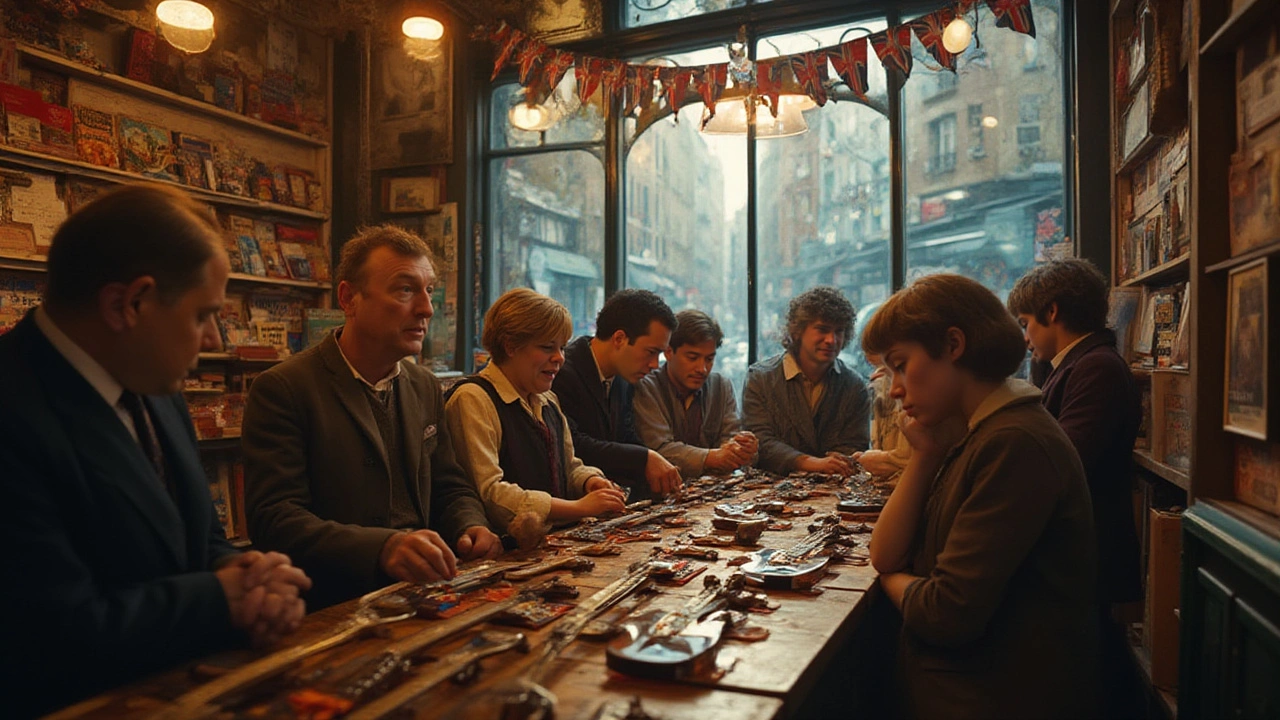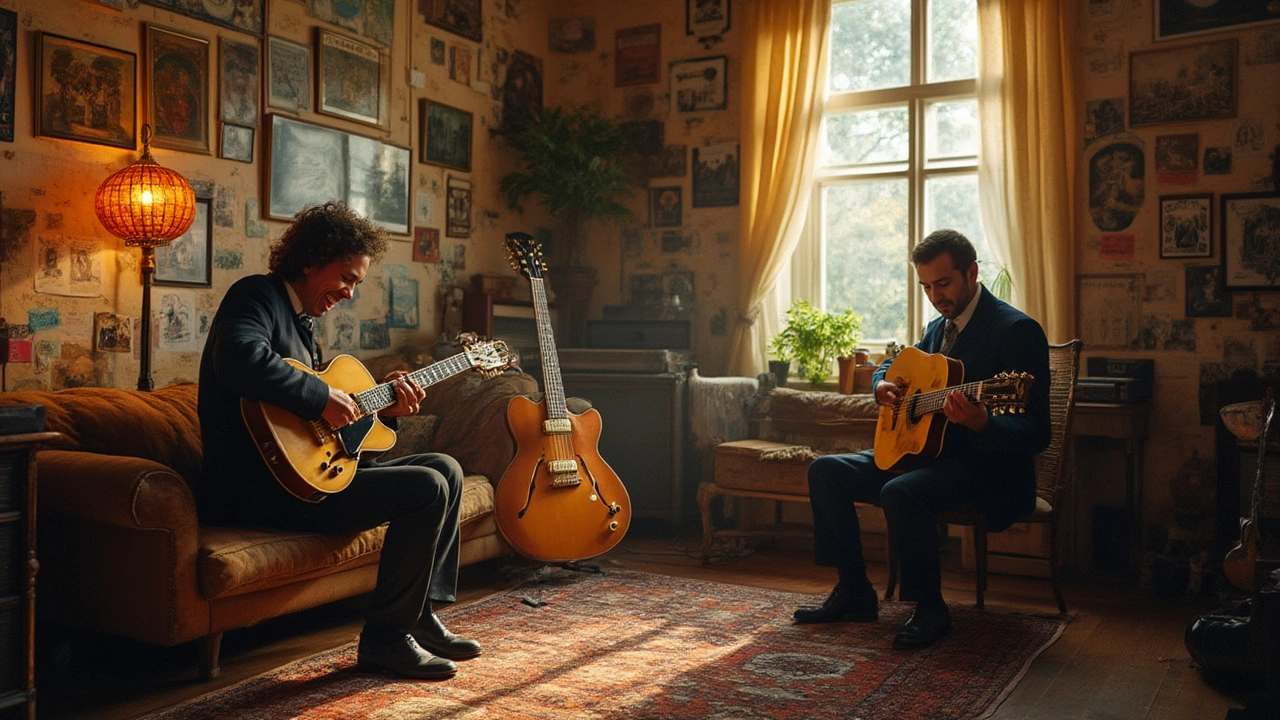If you scroll through Instagram long enough, you'll spot rare old-school Fenders and Gibsons showing up in every music lover's feed. Flip through a gear magazine or check out the latest from music YouTubers, and you'll see words like 'pre-CBS Stratocaster' or '1959 Les Paul Standard' everywhere. There’s a real buzz going on for these classic electric guitars—people are chasing them, bending over backwards to get their hands on real-deal vintage pieces. The fever’s not slowing down, either. This isn't just about nostalgia. It’s about sound, culture, investment, and something that feels a lot like magic in the hands. You don’t need a collector’s vault to join in, but it does help to know why these guitars are so sought-after, what makes them unique, and how you can jump on this trend whether you want one to play or as an investment piece.
What Makes Vintage Electric Guitars Special?
There’s just something about plugging in a guitar built before you were born and strumming a chord. People say it’s the tone, the story, maybe even the smell of old lacquer. But why do these guitars stand out so much compared to the new models hanging on the walls of big box music shops today? Let's break it down. Classic builders—take Fender in the '50s, for example—sometimes used woods that simply aren’t available anymore. Back then, lightweight swamp ash and great cuts of alder or mahogany were the norm. Now, these woods are pricey and rare. Older finishes like nitrocellulose lacquer (before regulations clamped down) gave guitars a unique look and feel; they wear and age in ways modern poly finishes just can’t copy. You’ll hear players gush about the way these old finishes ‘breathe’ compared to today’s guitars. The electronics have their own quirks: hand-wound pickups, vintage capacitors, and sometimes even idiosyncratic wiring. Ever heard a ‘blackguard Tele’ from the early '50s? The snap and bite is unlike anything rolling off production lines right now.
The factories themselves were smaller, and workers often treated each instrument with care that feels different from today’s fast-paced gigafactories. There’s real, tangible mojo in things like a 1965 Jazzmaster that came out of Leo Fender’s shop or a late-'50s Gibson ES-335. Even little things like the fonts used on headstocks—'spaghetti' vs. 'transition' logos on Fenders—now mean a lot to collectors and players. This obsession with detail hasn’t faded. In 2023, the biggest sales were often for guitars with documented originality: original paint, matching pots and pickups, original cases. These details drive prices way up and make every scuff or crack part of a guitar’s appeal, not a liability. Think about the worn fretboards or cigarette burns—each mark tells a story and adds value rather than taking it away, which is basically the opposite of how it works with, say, cars or tech gadgets.
There's also the whole 'player's touch.' Some say a broken-in neck just feels more playable after decades of gigs and practice sessions. Even the screws, tuners, and tailpieces have aged and settled in, making the instrument comfortable—like your favorite pair of old jeans. And, since I’m talking as someone whose Siamese cat Claudia once knocked over my 1972 Telecaster, I can confirm: older axes sometimes survive mishaps better than brand-new ones covered in plastic film. Everything just seems more resilient.
The Numbers: Vintage Guitar Market by the Stats
If you think this is a niche for old folks and collectors, you're missing the picture. According to the 2024 Guitar Market Analysis (yep, that’s a real annual report), vintage electric guitar sales hit a whopping $400 million worldwide last year alone. The biggest chunk comes from U.S. buyers, but European and Japanese collectors are closing in fast. Auction houses like Christie’s and Bonhams have had banner years, with Les Paul Standards from the '50s fetching over $1M—yes, seven figures!—and even "lesser" models from the '70s and early '80s doubling in value since 2018.
| Year | Vintage Market Value ($M) | Top Sale ($) | Volume Sold |
|---|---|---|---|
| 2021 | 269 | 850,000 | 12,000 |
| 2022 | 314 | 1,200,000 | 13,400 |
| 2023 | 357 | 1,085,000 | 14,750 |
| 2024 | 400 | 1,250,000 | 16,900 |
But it’s not all about the ultra-rare models. Even "modest" vintage guitars—think 1970s Stratocasters or Japanese-made lawsuit-era Les Pauls—are rising in value. As mainstream investors chase everything from classic cars to Pokémon cards, guitars hit this sweet spot: they're both art and a tool you can actually use. And, if you play your cards right, their value tends to beat inflation. Some popular YouTubers track this stuff and compare it to the S&P 500—guitars held their own, with vintage Fenders up 25% in value over the past five years. That’s wild compared to most mutual funds your bank offers.
Meanwhile, pop culture isn’t shy about fueling the trend. Harry Styles and Phoebe Bridgers rock old Fenders on stage, and movies keep the image alive. If you’re into the gearhead side of things, you’ll spot John Mayer demoing a '60s Strat, or Taylor Swift using a beat-up Telecaster in her music videos. The appetite goes wider than you'd think, from home jammers to bedroom TikTok stars. Even the rise in lo-fi music on streaming sites has boosted interest in older, analog-tinted sounds that only come from classic pickups and vintage wiring.
Let’s talk some quirks. The rise in popularity means the fakes are better than ever. "Relic" jobs (modern guitars made to look old) can trip up even longtime collectors. In 2023, one third of guitars offered as real vintage on large online platforms were flagged for authenticity issues after careful inspection, showing the importance of doing your homework or buying from trusted sources. There's also the insurance angle. Vintage guitars over $10,000 are now routinely insured like classic cars, with major underwriters reporting a 45% spike in new guitar-related policies last year.

How to Identify, Buy, and Care for a Vintage Electric Guitar
So you want a piece of this action? Here’s where the rubber meets the road. First, do your homework. Make, model, serial numbers, history—all matter here. Let’s say you’re eyeing a '70s Fender Telecaster. First, get pictures of the neck stamp, pot codes, pickups, and finish checking. If you can, bring a friend or a pro who knows their stuff. There’s a whole subculture online that can spot a refinished body, changed pickguard, or non-original tuners at a glance. Some models, like the Gibson Les Paul Standard 1958-60 or Fender Stratocaster 1954-65, come with hefty price tags for anything that’s "all-original"; even a changed screw can dent the price. For reference, check out guitar forums or Instagram accounts that post “guitar teardowns.” It’s a goldmine of real-world info right from the experts.
If you’re looking to buy, consider hitting up regional guitar shows, reputable vintage shops (some offer certificates of authenticity), or established dealers online. Avoid deals that seem too good to be true—chances are, they are. If you need reassurance, big dealers offer a 48-hour approval period where you can inspect the guitar and return it if it’s not as described. Ebay, Reverb, and Gbase are huge platforms, but do pay attention to seller feedback, return policies, and customer support. For ultra-high-end purchases, consider getting the guitar authenticated and appraised professionally. Think of it as buying a rare stamp—provenance is everything.
Once you’ve got your gem, take care of it. Keep vintage guitars stored in a stable climate: humidity around 45-50%, temperature steady, out of direct sun. Avoid rapid temperature changes—don’t leave your 1963 Jazzmaster in a freezing car overnight, please. Use the case, even if it’s heavy and ugly. Regularly check for fret wear, neck warp, and keep electronics clean (contact cleaner is your friend). I learned the hard way after my golden retriever Samson knocked over my old Jazz Bass—turns out, hanging guitars on a high enough wall is a wise move. For deep cleaning, avoid harsh chemical products, and use a soft, dry cloth for most surfaces. If you play regularly, change strings about every month and have a pro do setups once or twice a year, especially if you notice buzzing or intonation issues.
If you’re thinking about investment, make sure to keep receipts, provenance documents, and photos. This stuff adds value down the road. If you modify anything, save the original parts, even rusty screws or worn pickguards. Serious collectors care about every little piece.
- vintage electric guitars are best bought from trusted sources who offer returns and documentation.
- Research your model inside and out—details really matter in this game.
- Document and store everything: original cases, bridge covers, even tags and receipts.
- Avoid sudden climate shifts and always use a proper case.
- Start with "player-grade" models if you’re mostly a musician, not just a collector or investor.
Tips for Beginners, Collectors, and Investors
You don’t need to be an expert to catch the bug—or to start building a life with vintage guitars. The starting line is actually closer and more accessible than most people think. First tip: you can get into the vintage scene without breaking the bank by snagging "player-grade" instruments. These guitars might have a changed pickup or a refinned body, but they still have that real-deal vibe at a portion of the price. They're also a daily reminder that music gear is meant to be enjoyed, not just stashed away in a humidity-controlled vault. Some of my favorite sessions at home start with picking up my not-so-perfect '77 Musicmaster and letting Samson snuggle up at my feet.
Don’t get too obsessed with perfection. If you’re buying to play, a little wear, a swapped-out knob, or a repaired neck isn’t a dealbreaker. In fact, the real stories come from guitars that lived real lives—studio work, local gigs, maybe a beer spill or two. Those marks are badges of honor, not flaws to avoid. And if you want to go hardcore collector or investor? Start slow. Get to know the community. Join forums like The Gear Page or Les Paul Forum, or watch gear reviewers on YouTube who actually play and tear down vintage axes; you’ll pick up a ton just by listening and asking questions. Every dealer has seen newbies jump in blind and make costly mistakes. Few things feel worse than spending big on a "too good to be true" deal, only to find out the neck’s from a different year or the pickups are cheap replacements.
If you're treating guitars purely as an investment, there’s a golden rule: originality is king. Match those serial numbers, save old receipts, keep the case candy. And don’t ignore the "underdog" brands—old Yamaha SGs, Harmony, Silvertone, or Japanese Tokai Les Paul copies from the late '70s. A surprising number of these are rising stars now, especially as your typical Les Paul Standard or Stratocaster becomes ever more out of reach. The reality is, you don’t need a million bucks to ride this trend; you just need to dive in with your eyes open, know how to spot a deal, and maybe get a little lucky. Plus, you never know—one day your guitar might get its own epic backstory, whether it’s from the stage, the studio, or from Claudia’s accidental paw prints down the pickguard.
So, whether you’re playing at home, investing, or just gear-nerding with friends, vintage electric guitars bring something unmatched to the table. They're not just talking points—they spark creativity, keep your sound unique, and can be real financial winners in the right hands. The next time someone whips out a battered old Strat or a sunburst Les Paul with a few honest dings, ask about it. There might be magic (and a few great stories) behind every scratch.

